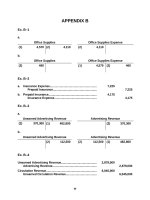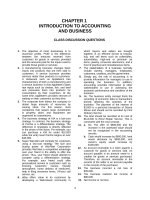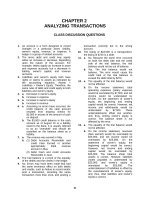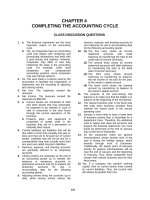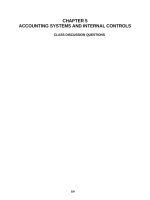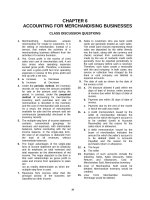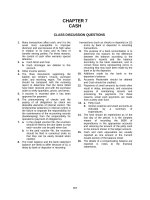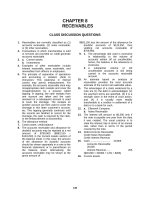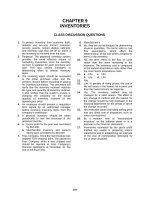Solution manual investments 10th by jones ch19
Bạn đang xem bản rút gọn của tài liệu. Xem và tải ngay bản đầy đủ của tài liệu tại đây (48.13 KB, 8 trang )
Chapter 19:
Portfolio Selection
CHAPTER OVERVIEW
Chapter 19 is a follow-up to Chapter 7, which discussed
the basics of Markowitz portfolio theory in terms of the
expected return and risk of a portfolio. Chapter 19
concludes this discussion by analyzing the efficient
frontier, the Single Index Model simplification of the
efficient frontier, how the efficient frontier is changed by
borrowing and lending, and the Separation Theorem. This
organizational structure allows students to concentrate on
related ideas together, and does not overwhelm them all at
once with the complete details of this important material.
Chapter 19 begins by discussing the steps involved in
building a portfolio of financial assets. The chapter
follows these steps.
The first step is to use the Markowitz portfolio
selection model to choose an efficient portfolio. The
efficient set of portfolios is explained in detail,
including the necessary information about indifference
curves. This discussion concludes with matching
indifference curves (preferences) with the efficient set
(possibilities). Important points about the Markowitz
analysis that often cause confusion are explained.
Alternative methods of obtaining the efficient frontier
via the Single Index Model are noted. This model is
developed in some detail. Multi-index models are also
considered.
This discussion includes an analysis of selecting
optimal asset classes (rather than individual assets) with
the Markowitz model. This brings up the topic of asset
allocation, which is defined at this point.
The second step involves the consideration of borrowing
and lending possibilities, which are explained in detail.
This discussion centers around the risk-free asset. The new
efficient set is illustrated.
Step three is to choose the final portfolio based on
preferences, given borrowing and lending possibilities.
20
This structure provides a smooth flow, from the Markowitz
efficient frontier to the straight-line set encountered when
borrowing and lending is considered.
The discussion in Chapter 19 provides a natural lead-in
to a discussion of the Separation Theorem. This discussion
assumes an investment firm with multiple clients or that all
investors have identical forecasts concerning the relevant
variables.
The implications of portfolio selection are discussed
as the conclusion to Chapter 19. At this point we
reemphasize the discussion at the end of Chapter 7--that the
relevant risk of an individual security is its contribution
to the riskiness of a well-diversified portfolio. This sets
the foundation for Chapter 20 because the return that should
be expected on the basis of this contribution can be
estimated using the CAPM.
CHAPTER OBJECTIVES
To supplement the brief analysis of portfolio theory in
Chapter 7 by showing the details of Markowitz portfolio
theory, and the Single Index Model.
To outline and describe the steps involved in building a
portfolio, starting with the efficient set and then
allowing for borrowing and lending possibilities.
To present the Separation Theorem.
21
MAJOR CHAPTER HEADINGS [Contents]
Building A Portfolio
[the steps involved]
Step 1: Use The Markowitz Portfolio Selection Model
Efficient Portfolios
[definition; diagram of the efficient frontier]
Selecting an Optimal Portfolio of Risky Assets
[indifference curves; tangency between indifference
curves and efficient set; important points about
Markowitz analysis]
Alternative Methods of Obtaining the Efficient Frontier
[the single-index model simplification; details of the
model; examples; discussion of return and risk using the
single index model; multi-index models]
Selecting Optimal Asset Classes
[applying Markowitz model to asset classes; the asset
allocation decision]
Step 2: Consider Borrowing And Lending Possibilities
[introducing the risk-free asset]
Risk-free Borrowing and Lending
[risk-free lending; borrowing possibilities; equations;
diagrams]
The New Efficient Set
[it is now linear, given borrowing and lending]
Step 3: Choose The Final Portfolio Based On Preferences
[match indifference curves with the straight line]
The Separation Theorem
[definition; explanation related to Figure 8-5; the
significance of this theory to investors]
22
The Implications of Portfolio Selection
[dividing total risk into systematic and nonsystematic
risk;]
POINTS TO NOTE ABOUT CHAPTER 19
Tables and Figures
There are no tables in Chapter 19.
Figure 19-1 illustrates indifference curves.
Figure 19-2 shows how a portfolio on the efficient
frontier is selected.
Figure 19-3 illustrates the Single Index Model,
including the difference between the actual return and the
estimated return.
Figure 19-4 illustrates how the Markowitz efficient
frontier is changed with borrowing and lending
possibilities.
Figure 19-5 shows the new efficient frontier when
borrowing and lending possibilities are allowed.
Box Inserts
Box 19-1 is a very valuable illustration of the
benefits of diversifying as it affects individuals. It
illustrates the concept of using asset classes to build a
portfolio that both earns high returns and reduces
volatility as compared to holding only one or two of these
assets.
The discussion in Box 19-1 involves the principles of
diversification and asset allocation, discusses key concepts
such as the S&P 500, volatility, money market funds, nondiversifiable risk, and so forth. As such, it is highly
recommended as an example of popular press discussion of
investment concepts and practices as they affect intelligent
individual investors.
23
ANSWERS TO END-OF-CHAPTER QUESTIONS
19-1.
The number of unique covariances needed for 500
securities using the Markowitz model is:
n(n-1)
──────
2
=
500(499)
────────
2
=
249,500
─────── = 124,750
2
The total pieces of information needed:
[n(n+3)]/2 = [500(503)]/2 = 251,500
19-2.
The number of covariances needed for 500 securities
with the Sharpe model is 500. The total pieces of
information needed is:
3n + 2 = 3(500) + 2 = 1502
19-3.
The Markowitz approach is built around return and
risk. The return is, in effect, the mean of the
probability distributions, and variance is a proxy
for risk. Efficient portfolios, a key concept, are
defined on the basis of return and risk.
19-4.
A stock with a large risk (standard deviation) could
be desirable if it has high negative correlation
with other stocks. This will lead to large negative
covariances which help to reduce the portfolio risk.
19-5.
The optimal portfolio for any investor occurs at the
point of tangency between the investor's highest
indifference curve and the efficient frontier.
19-6.
Rational investors seek efficient portfolios because
these portfolios promise maximum expected return for
a specified level of risk, or minimum risk for a
specified expected return.
19-7.
Conceptually, efficient portfolios are determined in
the following manner. Select a level of expected
return, for example, 10%. Varying the weights among
securities for which expected returns, variances and
covariances are available, determine the
combinations (portfolios) of securities with an
expected return of 10%. From this set, select the
24
portfolio with the lowest risk level. Next, select
a return of, for example, 11%, and repeat the
process. Continuing in this fashion will produce
the efficient frontier.
19-8.
An indifference curve describes investor preferences
for risk and return. Each indifference curve
represents all combinations of portfolios that are
equally desirable to a particular investor given the
return and risk involved. Thus, an investor's risk
aversion would be reflected in his or her
indifference curve. The curves for all risk-averse
investors will be upward-sloping, but the shapes of
the curves can vary depending on risk preferences.
19-9.
The introduction of a risk-free asset introduces the
possibilities of borrowing and lending into the
Markowitz analysis. Once these possibilities are
allowed, the efficient set of portfolios changes
from the Markowitz efficient set arc to a straight
line.
19-10.
Lending portfolios refer to the case where part of
the portfolio funds are placed in the risk-free
asset, which is typically proxied by Treasury bills.
When an investor purchases T-bills, he or she is, in
effect, lending money to the Federal government.
19-11.
The separation theorem states that the investment
decision (which portfolio of risky assets to hold)
is separate from the financing decision (how to
allocate investable funds between the risk-free
asset and the risky asset). One risky portfolio is
optimal for every investor regardless of that
investor's utility function.
19-12.
The separation theorem, given multiple clients or
complete agreement by all concerned about the future
prospects of securities, argues that the “tailoring”
process (whereby each client is matched with a
portfolio designed specially for that individual) is
inappropriate. All investors should hold the same
portfolio of risky assets and achieve their own
position on the risk-return tradeoff through
borrowing and lending. The opportunity set is the
same--investors with different preferences can be
accommodated with this same opportunity set.
25
CFA
19-13.
a
CFA
19-14.
b
19-15.
d
19-16.
d
19-17.
a
19.18.
d
26
ANSWERS TO END-OF-CHAPTER PROBLEMS
19-1.
This is best solved using software.
(a)
The highest expected return is 25% (the upper
boundary) for portfolio 5.
(b)
The lowest standard deviation is for portfolio
#1.
(c)
All portfolios except #2 involve short sales.
(d)
By definition, all portfolios are efficient.
An investor would have to choose the one most
suitable to his or her risk-return preferences.
19-2.
Changing the correlation coefficient between
securities 1 and 2 to -0.20 from 0.20 does not
change the expected returns on the portfolios. The
risk of each portfolio is lowered because of the
desirable negative correlation, although the change
in risk for portfolio #3 is barely perceptible. The
weights of each security in each of the portfolios
also change.
19-3.
To answer this question, eliminate the dominated
portfolios by either comparing the return and risk
for various pairs, or by graphing the portfolios.
For example, portfolio 1 is dominated by portfolio 9
(higher return and lower risk). The set of
dominated portfolios include: 1, 2, 3 and 5. The
remaining portfolios are in the efficient set.
19-4.
b (12 X 20 X .30)
19-5.
a (50% X 16% + 50% X 22% = 19%)
19-6.
a
27
